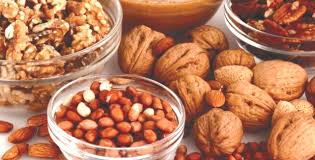By K.M. LEW
Folate (or Folic Acid)
One of the B vitamins, folate is crucial to the growth and reproduction of all cells in adults and for maintaining DNA for normal cell production (including the immune system's white blood cells, which help fight disease), says Karen Collins, nutrition adviser and registered dietitian at the American Institute for Cancer Research. Concerns about the potential effect of folate deficiency prompted the U.S. government to have foods such as cereal fortified with the nutrient, which makes taking in the recommended dietary allowance (RDA) of 400 micrograms fairly easy for adults. Eating healthy plant-based foods will also get you there: dark-green vegetables such as broccoli and spinach provide 100 to 200 micrograms per cup, while lentils contribute about 350 micrograms per cup.

Sources
Dried beans, leafy greens (kale, romaine, spinach), fortified cereals, and whole grains
Vitamin B6
B6 helps to produce antibodies that are needed to fight diseases, including heart disease. The RDA is 1.3 milligrams for adults 50 or younger and slightly higher for those who are older. Bananas and potatoes are particularly rich in vitamin B6: A medium banana provides .68 milligrams and a medium baked potato (with the skin) has .7 milligrams.
Sources

Dried beans, fish, some produce (bananas, potatoes, avocados, cauliflower), poultry, lean red meat, and whole-grain breads
Vitamin C
Vitamin C increases the production of infection-fighting white blood cells and antibodies, as well as interferons, a group of antiviral proteins. Massive amounts of vitamin C aren't needed to reap its benefits. The RDA is only 75 milligrams for women and 90 milligrams for men, although many researchers suggest aiming for 200 milligrams a day.
Sources
Dark-green vegetables (kale, broccoli), kiwi, and yellow and orange produce (citrus, bell peppers)
Phytochemicals (aka Phytonutrients)
This large group of nutrients boosts the number of infection-fighting cells in the body. The term comprises carotenoids and bioflavonoids.
Sources
Deeply hued produce of all colors (blueberries, carrots, sweet potatoes) and dark, leafy greens
Zinc
This mineral is needed for developing and activating the immune system's T cells, which are white blood cells that fight off infection. Zinc helps white blood cells release more antibodies. The RDA is 8 milligrams for women, 11 milligrams for men. Taking too much zinc may actually produce negative results, such as iron deficiency and decreased immunity function. The National Academy of Sciences has set 40 milligrams as the maximum recommended daily intake for adults. Because the mineral is plentiful in many foods, experts generally don't suggest using supplements.

Sources
Dried beans, lean red meat, nuts, poultry, seafood (especially shrimp and oysters), pumpkin and sesame seeds, whole grains, and yogurt
Folate (or Folic Acid)
One of the B vitamins, folate is crucial to the growth and reproduction of all cells in adults and for maintaining DNA for normal cell production (including the immune system's white blood cells, which help fight disease), says Karen Collins, nutrition adviser and registered dietitian at the American Institute for Cancer Research. Concerns about the potential effect of folate deficiency prompted the U.S. government to have foods such as cereal fortified with the nutrient, which makes taking in the recommended dietary allowance (RDA) of 400 micrograms fairly easy for adults. Eating healthy plant-based foods will also get you there: dark-green vegetables such as broccoli and spinach provide 100 to 200 micrograms per cup, while lentils contribute about 350 micrograms per cup.

Sources
Dried beans, leafy greens (kale, romaine, spinach), fortified cereals, and whole grains
Vitamin B6
B6 helps to produce antibodies that are needed to fight diseases, including heart disease. The RDA is 1.3 milligrams for adults 50 or younger and slightly higher for those who are older. Bananas and potatoes are particularly rich in vitamin B6: A medium banana provides .68 milligrams and a medium baked potato (with the skin) has .7 milligrams.
Sources

Dried beans, fish, some produce (bananas, potatoes, avocados, cauliflower), poultry, lean red meat, and whole-grain breads
Vitamin C
Vitamin C increases the production of infection-fighting white blood cells and antibodies, as well as interferons, a group of antiviral proteins. Massive amounts of vitamin C aren't needed to reap its benefits. The RDA is only 75 milligrams for women and 90 milligrams for men, although many researchers suggest aiming for 200 milligrams a day.
Sources
Dark-green vegetables (kale, broccoli), kiwi, and yellow and orange produce (citrus, bell peppers)
Phytochemicals (aka Phytonutrients)
This large group of nutrients boosts the number of infection-fighting cells in the body. The term comprises carotenoids and bioflavonoids.
Sources
Deeply hued produce of all colors (blueberries, carrots, sweet potatoes) and dark, leafy greens
Zinc
This mineral is needed for developing and activating the immune system's T cells, which are white blood cells that fight off infection. Zinc helps white blood cells release more antibodies. The RDA is 8 milligrams for women, 11 milligrams for men. Taking too much zinc may actually produce negative results, such as iron deficiency and decreased immunity function. The National Academy of Sciences has set 40 milligrams as the maximum recommended daily intake for adults. Because the mineral is plentiful in many foods, experts generally don't suggest using supplements.
Sources
Dried beans, lean red meat, nuts, poultry, seafood (especially shrimp and oysters), pumpkin and sesame seeds, whole grains, and yogurt





0 comments:
Post a Comment